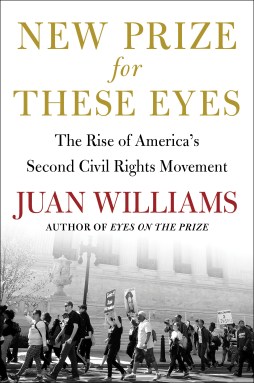The Civil Rights Movement, Part II

“New Prize for These Eyes: The Rise of America’s Second Civil Rights Movement” by Juan Williams
c.2025,
Simon & Schuster
$28.99
271 pages
You’re not letting go that easily.
No, you’re on the right side of justice and you’re not letting go of the issue. Your heels are dug in, your back is straight, and your resolve is steely. You have a plan and you’ll keep it, and see it to the end no matter what happens. As in the new book “New Prize for These Eyes” by Juan Williams, there are some who’ve gone before you but your effort is what matters now.
History disagrees on the exact catalyst for the civil rights movement, but Juan Williams says that “the second Civil Rights Movement” sparked at the 2004 Democratic National Convention, and it took less than 20 minutes.
“New Prize for These Eyes” author, Juan Williams. Photo by Frank GravesNot long after young Senator Barack Obama, whose presence was meant to attract Black voters, began his speech at that convention, he had the audience cheering. He was positive, energetic, and energizing, and spoke of “a new sense of common purpose,” which spurred a Second Civil Rights Movement and a mandate to “deal with… cultural issues that the First Movement had left unresolved…”
The speech thrust Obama onto the national stage and, with the endorsement of many old guard Civil Rights Movement figures, ultimately put him in the White House. His presence there wasn’t without issues, both politically and racially, however: the deaths of Trayvon Martin, Michael Brown, and Philando Castile absolutely affected Obama’s terms, in part because “he acted only as a referee” and didn’t “take any special level of response as a Black man.” Still, early civil rights leaders agreed with him that America was “better” then than it was sixty years prior.
Before Obama’s second term was over, a “right-wing backlash” that was “fueled by grievance” ushered Donald Trump into office but by then, young Black Americans had flocked to social media and gave root to the Black Lives Matter movement. “Covid-19 would also transform” the situation.
By the summer of 2024, “the Second Civil Rights Movement was far from completing its agenda,” says Williams, but “it had still achieved remarkable success.”
Play very close attention while you’re reading this book. It’s filled with politics, but there’s a pay-off in it: author Juan Williams does a little forecasting toward the end of “New Prize for These Eyes,” promising readers a new movement, a third one, to come.
Even if you’re not particularly a politics-watcher, Williams commands your attention to the last twenty years and how they keenly shaped racism and racial issues in America. Sometimes, he seems to invite argument, using Obama as a singular catalyst for this “Second” movement and its current continuation, fairly or unfairly; and he places other credits on people and events that will make readers want to find someone to discuss it. The tantalizing idea of a third movement will only underscore that desire.
As a sequel to Williams’ Eyes on the Prize, this is a must-read for anyone who knows where we’ve been or wonders where we’re going. Find “New Prize for These Eyes.”
You won’t want to let it go.





